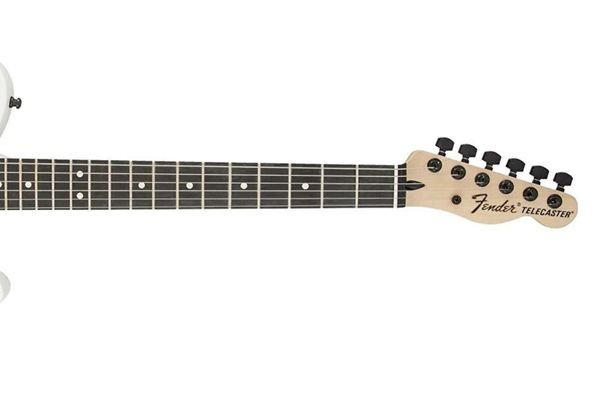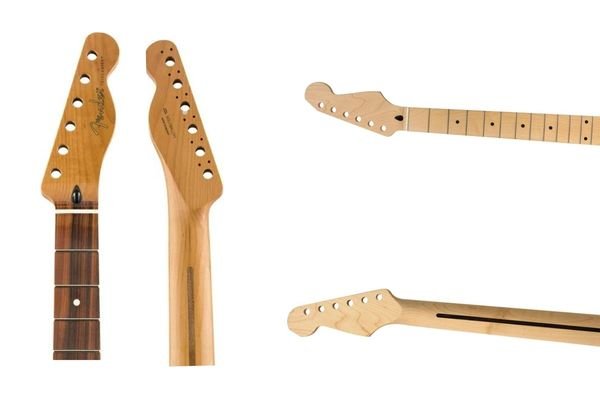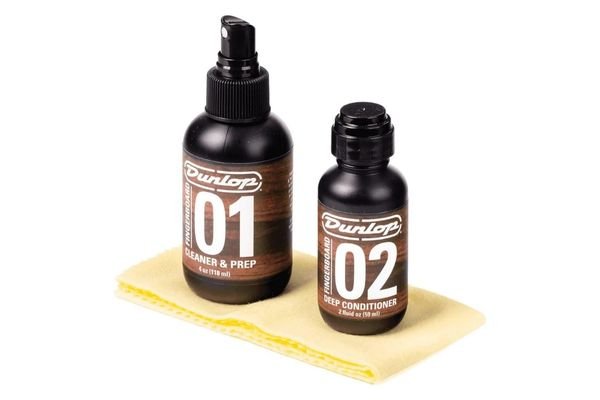Pau Ferro vs Maple as tonewoods are different from each other, like Rosewood vs Ebony Pau Ferro and Maple have distinct characteristics, making them suitable for different styles of playing. Pau Ferro is a dense and heavy wood with a tight grain structure, which provides a rich and articulate sound. Maple fretboards, on the other hand, are light and have a bright tone that also comes with tight grain, making them more mellow and less aggressive than Pau Ferro.
Talking about Pau Ferro vs Maple Fretboards, Maple became popular when Fender used them in their Stratocasters and Telecasters decades ago. On the other hand, after Rosewood was restricted to use in 2017, Pau Ferro became a very popular alternative. Mainly, Fender’s Player Series guitars introduced Pau Ferro as a substitute for Rosewood.
As both fretboards are really popular and are used in lots of guitars in the market, it can be a bit tough for you when choosing between Pau Ferro vs Maple fretboards. Both are quality tonewoods, but they have their own advantages and disadvantages. So, it’s important to understand their differences before making the decision.
Read More: Indian Laurel vs Rosewood
In this post, I will talk about all the qualities of Pau Ferro vs Maple fretboards by looking at their differences in sound, playability, durability, and more. So, let’s begin.
- What Is Pau Ferro?
- What Is Maple?
- Pau Ferro vs Maple: Comparision At a Glance
- Pau Ferro vs Maple vs Rosewood vs Ebony Fretboard Wood Comparison Table
- Pau Ferro vs Maple Comparison: 6 Key Differences
- How To Care Pau Ferro Fretboard?
- How To Care Maple Fretboard?
- Pau Ferro vs Maple: Conclusion
- Pau Ferro vs Maple: FAQ
What Is Pau Ferro?
Pau Ferro is a perfect alternative to Brazilian Rosewood, considering its looks and tonal qualities. It comes with open-grained hardwood and a non-porous surface. Pau Ferro is widely found throughout South America and has a diverse range of grain patterns and colors that comes in two different shades. Its material absorbs small frequencies, which makes Pau Ferro a better choice for guitars. Especially its sturdy nature is suitable for fingerboards.
Pros and Cons of Pau Ferro Fretboard
Manufacturers like Fender is using Pau Ferro wood on modern guitar models due to its sustainability. But it has some downsides too. Here’s a breakdown of the pros and cons of the Pau Ferro fretboard.
Pros
- Pau Ferro is a hard and dense wood that doesn’t warp easily
- It is resistant to humidity, making it a great option for players who live in areas with humidity changes
- It has a dark and rich tone that allows improved resonance
- It provides excellent playability, with a smooth feel and low action
Cons
- Requires frequent maintenance and conditioning
- As it is a dense wood, replacing frets or making repairs can be a bit difficult
What Is Maple?
The Maple fretboard of a guitar is one of the most popular materials used in constructing guitars. It is a hardwood that provides a smooth surface for the musician to play on. If you are looking to add a bit of brightness and clarity to the playing, the Maple fretboard is for you. Even if they are often seen on electric guitars, acoustic guitar manufacturers also use Maple a lot.
Moreover, Maple fretboards are known for their superior playability, as they are comfortable to play on and offer a clean, even feel. With strong resonance and a sharply defined top end, the Maple fretboard is a popular choice for any guitarist looking for a high-quality fretboard.
Pros and Cons of Maple Fretboard
Maple fretboard is aesthetically pleasing with its light color hue and attractive grain pattern. But just like Pau Ferro, Maple also comes with a few drawbacks. Here’s a quick breakdown of the pros and cons of Maple fretboard.
Pros
- Maple fretboards offer a bright and clear sound, which is well-suited for a variety of musical genres
- They are highly durable and can withstand a great deal of wear and tear
- Its bright sound and smooth playing surface allow for fast and accurate playing
- They are easy to maintain and can last a long time
Cons
- The tone of the maple fretboard can be too bright for some players
- A bit more expensive than Pau Ferro fretboards.
Pau Ferro vs Maple: Comparision At a Glance

Pau Ferro vs Maple vs Rosewood vs Ebony Fretboard Wood Comparison Table
| Features | Pau Ferro | Maple | Rosewood | Ebony |
 |  |  |  | |
| Type of Wood | Hardwood | Hardwood | Hardwood | Hardwood |
| Color hue | Dark brown to reddish | Golden to reddish brown | Brown/ golden brown to reddish | Rich brown to almost jet black |
| Grain | Straight, irregular | Straight or wavy | Straight or wavy | Straight |
| Density of wood | 865 kg/m3 / 54.0 lb/ft3 | 530 kg/m3 / 33.1 lb/ft3 | 800 kg/m3/ 50 lb/ft3 | 625 kg/m3/ 39 lb/ft3 |
| Hardness | 8,710 N / 1,960 lbf | 3,110 N / 700 lbf | 7,900 N/ 1,780 lbf | 16,000 N/ 3700 lbf |
| Elasticity | 10.86 GPa / 1,575,000 psi | 7.86 GPa / 1,140,000 psi | 11.5 GPa / 1,667,934 psi | 18.82 GPa/ 2,730,000 psi |
| Tone | Warm | Bright | Warm | Bright |
| Cost | Moderate | Moderate | Expensive | Expensive |
Pau Ferro vs Maple Comparison: 6 Key Differences
Here are the 6 key differences between Pau Ferro vs Maple Fretboards that will help you determine which one suits you the best.
1. Appearances:
Both the Pau Ferro vs Maple woods have distinct appearances, where Pau Ferro has a deep brown color with a reddish hue, and Maple has a light tan color with a creamy white hue. Pau Ferro also has a very deep grain pattern, while Maple has a more subtle grain pattern. Additionally, Pau Ferro fingerboards are mainly unfinished, and Maple comes with various finishes. However, Pau Ferro also has finished types (thin, matt satin finish), and Maple also has an unfinished type.
2. Feel:
Feel is one of the most important factors when you are deciding between two tonewoods. Pau Ferro feels smooth in your hands. Whether finished or not, the Pau Ferro fretboard offers very little friction allowing effortless soloing.

In contrast, the Maple fretboard’s feel depends a lot on whether it has a finish or not. An unfinished Maple fretboard is more convenient to play with and has a more polished appearance. In contrast, Maple with a glossy finish can feel a bit sticky.
3. Tone & Sonic Qualities:
Pau Ferro and Maple fretboards have distinct sonic qualities and tonal differences. Pau Ferro is a dense and heavy wood with a rich, warm, mellow tone. It has a nice mid-range focus, making it great for blues, jazz, and funk styles.
In contrast, Maple provides a light and bright tone. It has less low-end but more high-end, making it great for rock, metal, and other high-energy genres. The sustain is also longer with a Maple fretboard, as it is more efficient at vibrating the strings. Ultimately, the choice between Pau Ferro vs Maple comes down to personal preference and the desired tonal characteristics of the instrument.
4. Durability:
Pau Ferro is renowned for its superior durability compared to Maple. Pau Ferro is harder and denser than Maple, making it more resistant to dents and scratches. Additionally, it is less susceptible to warping and shrinkage, so it can hold its shape better during extreme temperature or humidity changes. In short, Pau Ferro is a great choice for guitarists looking for a fretboard that can stand up to the rigors of regular use.
On the other hand, Maple fretboards are made from a softer wood compared to Pau Ferro, making them more prone to wear and tear but also allowing for more tonal clarity and brightness. Overall, both fretboards offer excellent durability and playability, but Pau Ferro is generally considered to be the more durable of the two.
5. Playability:
Pau Ferro and Maple fretboards both offer excellent playability for guitar players. Pau Ferro has a slightly harder feel than Maple, providing a bit more control to the player than Maple. The hard surface of Pau Ferro also helps in reducing finger noise when playing, making it great for recordings.
On the other hand, Maple fretboards are softer and provide more grip to the player. This makes them excellent for string bends. The softer feel can also be great for rhythm playing. Both Pau Ferro and Maple fretboards provide great playability, so it comes down to personal preference as to which one to choose.

6. Neck:
The neck of a Pau Ferro fretboard is a great choice for guitarists who are looking for a strong, durable, and smooth playing experience. Pau Ferro wood is known for its tight grain, which is why it is so strong and durable. The tight grain also allows for a very smooth playing experience; there will be no buzzing or warping of the strings.
In contrast, the Maple fretboard does not have the same durability as the Pau Ferro fretboard. It’s a soft wood compared to Pau Ferro. Ultimately, the neck of a Pau Ferro fretboard is a great choice for guitarists who are looking for a strong, durable neck.

How To Care Pau Ferro Fretboard?
Caring for or maintaining a Pau Ferro fretboard is easy. Here are some steps and tips that you can follow to maintain your Pau Ferro fretboard.
Step 1: Regularly clean the fretboard with a clean, dry cloth. If the fretboard has accumulated dirt, you can use a bit of water and a soft cloth to gently clean the fretboard.
Step 2: From time to time, oil the fretboard with a quality fretboard oil, such as lemon oil (product URL like Dunlop oil), to help keep the wood from drying out or cracking. When applying the oil, it is important to use a very light coating, as too much can clog the pores of the wood and make it difficult to keep it clean.
Tips:
- Always keep the fretboard clean of any dirt or sweat that accumulates over time.
- Regularly check the frets and make sure that the fretboard is not becoming too dry.
With regular cleaning and maintenance, a Pau Ferro fretboard can last for many years.
How To Care Maple Fretboard?
Caring for a Maple fretboard on your guitar is essential to keep it looking and sounding great. Follow the below steps to maintain your Maple fretboard properly.
Step 1: Clean the fretboard regularly with a soft cloth, removing dust and dirt build-up. It is also important to use a cleaner specifically made for fretboards, as regular cleaners can damage the finish. This fretboard cleaner from Dunlop) always gave me the best result.
Step 2: From time to time, oil the fretboard with a guitar fretboard oil to prevent drying and to crack. Be sure to work the oil into the fretboard with a soft cloth, and then wipe off any excess oil.
Step 3: Apply a thin coat of fretboard conditioner, which will help to protect the wood and give your guitar a smooth, glossy finish.
Pau Ferro vs Maple: Conclusion
Pau Ferro vs Maple fretboards each have unique advantages and disadvantages regarding sound quality, durability, and playability; we have already discussed that. Ultimately, it is up to the individual musician to decide which type of fretboard is best suited for their playing style and instrument. Both Pau Ferro and Maple are great options, and you should experiment with both to find the right fit for you. However, both fretboard materials have one thing in common: they provide a superb playing experience that is expected of them.
Pau Ferro vs Maple: FAQ
Is Pau Ferro Good Fretboard?
Pau Ferro is an extremely popular choice for fretboard wood due to its durability and natural beauty. It has a striking deep reddish-brown color that stands out from the crowd and a very smooth texture that is comfortable to the touch. It has a smooth, warm and rich tone that is well-suited for many playing styles. It is also incredibly durable and resistant to wear and tear, making it a great choice for busy players.
Moreover, its density makes it an excellent choice for fretboard wood because it can withstand a lot of wear and tear and won’t easily warp or become brittle. All in all, Pau Ferro is a great choice for anyone looking for quality fretboard wood; you can’t get anyone better than the Fender to testify that!


